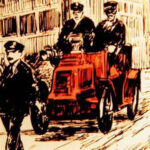The origin of car horns can be traced back to England in the early 19th century.
>> Car horns can be quite annoying
The English Law
Car horns have become an integral part of everyday life. In fact, they are synonymous with cars, as it is hard to find a car without a horn.

Car horns were invented during the time of horse-drawn carriages. In the early 19th century, steam-powered cars became popular in England. To ensure the safety of pedestrians and animals, a law was passed, stating: “…Motor vehicles traveling on the streets must have a pedestrian guide ahead to wave a flag and blow a horn to notify.”
Bulb horn
In the late 19th century, car drivers invented signaling devices for vehicles, including bulb horns, horns, and bells. In the United States, bells were mainly used. Although these devices still made noise on the streets, compared to the sound of horseshoe pounding and the sound of wheels on stones, the sound of bells was much quieter.

In the early 20th century, the first bulb horn was introduced in France and quickly spread to the United States. The sound of this horn was softer and more pleasant than the sound of bells.
Exhaust horn
By 1910, many drivers wanted a more effective warning device: a horn that could be heard at least 1/8 mile away. Manufacturers rushed to produce new horn designs, some of which were powered by exhaust gas.
The Sireno horn, named after a mythical creature in Greek mythology that used enchanting songs to lure and kill sailors, was once advertised as a horn that could be heard a mile away. Another horn called Godin was introduced with the catchy slogan at that time, “Honk while driving, have a comfortable journey”.
Gabriel and Klaxon horns
One of the most famous car horns from 1910 to 1920 was the Gabriel horn, named after the god who blew the trumpet. The Gabriel horn produced multiple different sounds. The sound was loud and strong but still comfortable for the listener.

In addition, another famous horn is the Klaxon. This is a horn with roots in Greek. Klaxo means “shout” and it produces sound by an electrically-charged metal diaphragm. The Klaxon horn was the first horn that only needed to be pressed once to make a sound instead of continuously pressing it to clear the way ahead.
Horn sound
The Klaxon-style horn continued to be developed in the following years and became the foundation for modern membrane horns. Manufacturers experimented with different diaphragm and horn designs to create a variety of sounds. One of the most notable is the “Aoogha” sound of the horns equipped on Ford Model T and Model A cars from the 1920s to the early 1930s.
During those years, many studies and new designs were applied in the production of car horns to create the most pleasant sound while still being audible in noisy traffic. Until the mid-60s, the American-style car horn was adjusted to produce a sound at the E flat or C note. Since then, many manufacturers have continued to improve the sound of car horns and raised it to the F sharp or A sharp note.
History of anti-horn abuse
Noise levels in traffic are increasing, and as a result, car manufacturers are making every effort to create interior designs with reduced noise levels close to zero.
In fact, they have been quite successful. Even the siren horn, which is usually louder than a regular horn, is difficult to hear when you are sitting in a car with the air conditioning on and the windows closed. Even with the windows open and the car moving at high speeds to maximize the noise inside the cabin, it is still difficult for the person inside the car to hear the horn signal.

However, pedestrians and residents living near the street are the ones who bear the brunt of the horn noise. For many years, they have requested authorities to enact laws to restrict horn honking on the streets.
By 1912, a large number of cities had enacted ordinances requiring vehicles to be equipped with warning horn systems and to avoid excessive horn use in the city. Throughout the 50s, 60s, and 70s, some states in the United States experimented with laws regulating the use of car horns while still allowing drivers to use them. Many local and regional laws are still in effect today.
Th? Ð?t (TTTÐ/Ford)











































